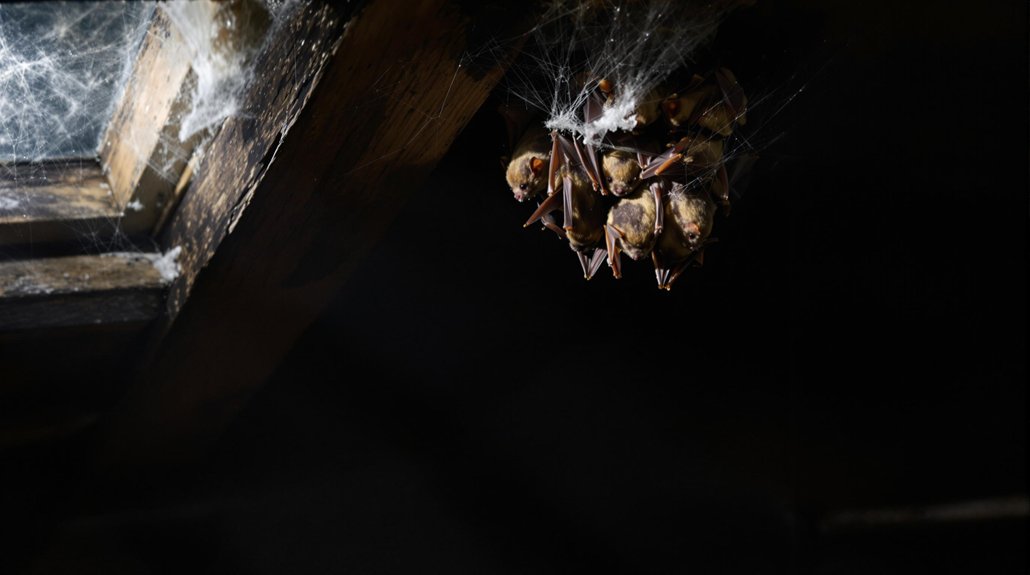Leaving bats in the attic is not advisable. While bats control insect populations, they can pose health risks. Bats carry diseases like rabies and their droppings can cause respiratory issues. Additionally, their presence could lead to damage in your home from guano accumulation and structural wear. Many regions have laws protecting bats, making humane removal necessary. It's also vital to avoid disturbing them during breeding season. Finding ways to coexist, such as installing bat houses outdoors, can help. There are significant factors to examine before making a decision about bats in your attic.
Key Article Highlights
- Leaving bats in the attic is not advisable due to health risks like rabies and respiratory issues from bat droppings.
- Bats are protected by law, making humane removal necessary, especially during breeding season.
- Accumulated guano can damage insulation and compromise indoor air quality, leading to costly repairs.
- Bats provide natural pest control, but their presence in living spaces can decrease property value and livability.
- If bats are in your attic, consider installing bat houses outside to encourage them to roost away from your home.
Understanding Bat Behavior
Understanding bat behavior is essential for homeowners considering how to handle these creatures in their attics. Bats are known for their unique habits and nocturnal activity. These small mammals typically emerge at dusk to forage for food, primarily insects. This feeding pattern is vital as it helps control insect populations, making bats beneficial to the environment.
Bats often roost in dark, secluded places during the day, which is why attics are a common habitat. They are social animals and tend to live in colonies, which can range from a few individuals to thousands. Understanding their habits can help homeowners appreciate their role in the ecosystem.
While bats are generally not aggressive, their presence can be concerning for some. It is important to recognize that they are protected by law in many areas, which means removal should be done carefully and humanely. Observing their behavior can provide insight into when they are active and the best times to safely address any concerns. By learning about bat habits and their nocturnal activity, homeowners can make informed decisions about how to manage these creatures in their homes.
Health Risks of Bats
Bats can pose several health risks to humans and pets if they inhabit an attic. One major concern is the transmission of bat diseases. Bats are known carriers of rabies, a viral infection that can be deadly if not treated promptly. If a bat bites a person or pet, it is essential to seek medical help immediately.
Another risk comes from bat droppings, also known as guano. These droppings can contain harmful fungi, which may cause respiratory issues when inhaled. A common disease associated with bat droppings is histoplasmosis, which can lead to lung problems. People who have weakened immune systems are particularly at risk.
Moreover, the presence of bats can attract other pests, such as parasites. Fleas, ticks, and mites can spread from bats to pets and humans, increasing the risk of additional health issues.
Legal Aspects of Bat Removal
Steering through the legal aspects of bat removal is vital for homeowners facing an infestation. Bats are often protected under bat conservation laws, which vary by region. These laws are in place to protect bat populations, as many species are threatened or endangered. This means that homeowners cannot simply remove bats at will.
Humane removal is the preferred approach when dealing with bats in the attic. It is important to hire a professional who understands both the legal requirements and the best methods for safely relocating bats. Professionals can help guarantee that the removal process does not harm the bats or violate any laws.
In many areas, it is illegal to remove bats during their breeding season, which typically occurs in the spring and summer months. Homeowners must wait until the young bats are old enough to fly before any removal efforts can begin.
Failing to follow these legal guidelines can result in fines and other penalties. Consequently, it is essential for homeowners to familiarize themselves with local bat conservation laws and to seek professional help for humane removal. This approach not only protects the bats but also guarantees compliance with the law.
Impact on Your Property
Leaving bats in the attic can have several negative impacts on your property. While bats are beneficial to the ecosystem, their presence in your home can lead to significant concerns. Here are three main issues to take into account:
- Property Damage: Bats can cause structural damage as they create entry points and nests. Their droppings, known as guano, can corrode materials and lead to costly repairs.
- Insulation Issues: The accumulation of bat guano can compromise insulation. As droppings collect, they can create dampness, leading to mold growth and reduced energy efficiency in your home.
- Health Risks: Bats can carry diseases that may pose health risks to humans. Their droppings can harbor pathogens that, if disturbed, may become airborne and affect indoor air quality.
Coexisting With Bats
Coexisting with bats can be a delicate balance, as these creatures play a significant role in controlling insect populations and maintaining ecological health. Bats offer many bat benefits, especially in natural pest control. They consume large numbers of insects, including mosquitoes, moths, and beetles. This helps reduce the need for chemical pesticides, promoting a healthier environment.
To coexist peacefully with bats, it is important to create a welcoming habitat for them outside your home. Planting native flowers and trees can attract insects, providing food for bats. Installing bat houses can give them a safe place to roost, away from your attic or other areas of your home. This way, you can enjoy the advantages of having bats nearby while keeping them out of unwanted spaces.
If bats are already living in your attic, consider leaving them undisturbed during their maternity season, which typically runs from May to August. Disturbing them during this time can harm the young bats. After the season, you can safely seal entry points to prevent future access. By understanding bat benefits and fostering a safe environment, you can successfully coexist with these beneficial creatures.
Frequently Asked Questions
How Do I Know if Bats Are in My Attic?
Ah, the elusive attic bat! To confirm their presence, look for bat droppings identification scattered about and listen for bat sounds detection, such as chirps or squeaks, echoing through the rafters. A true auditory adventure!
Can Bats Damage Insulation or Wiring in My Attic?
Bats can cause significant damage to insulation and wiring. Bat droppings can lead to insulation contamination, creating health risks and reducing energy efficiency. It is crucial to address any bat presence promptly to prevent further complications.
What Time of Year Are Bats Most Active?
Bats exhibit seasonal activity, typically being most active during warmer months, from spring to early fall. They hibernate in colder months, seeking shelter to conserve energy and survive harsh conditions. Understanding this cycle is essential for management.
How Can I Discourage Bats From Entering My Attic?
To discourage bats from entering your attic, use bat repellents and implement exclusion methods. Seal entry points, install one-way doors, and create an unwelcoming environment to effectively keep bats away from your living space.
What Should I Do if I Find a Bat Indoors?
If you find a bat indoors, prioritize indoor safety by isolating the area. Contact a professional for bat removal, as they can safely relocate the bat without harming it, ensuring both your safety and the bat's well-being.

